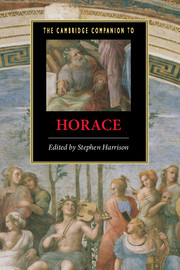Book contents
- Frontmatter
- Introduction
- Part 1: Orientations
- Part 2: Poetic Genres
- Part 3: Poetic Themes
- Part 4: Receptions
- 20 Ancient receptions of Horace
- 21 The reception of Horace in the Middle Ages
- 22 The reception of Horace in the Renaissance
- 23 The reception of Horace in the seventeenth and eighteenth centuries
- 24 The reception of Horace in the nineteenth and twentieth centuries
- Dateline of works and major political events
- Works cited
- Index
20 - Ancient receptions of Horace
from Part 4: - Receptions
Published online by Cambridge University Press: 28 May 2007
- Frontmatter
- Introduction
- Part 1: Orientations
- Part 2: Poetic Genres
- Part 3: Poetic Themes
- Part 4: Receptions
- 20 Ancient receptions of Horace
- 21 The reception of Horace in the Middle Ages
- 22 The reception of Horace in the Renaissance
- 23 The reception of Horace in the seventeenth and eighteenth centuries
- 24 The reception of Horace in the nineteenth and twentieth centuries
- Dateline of works and major political events
- Works cited
- Index
Summary
Propertius to Statius
The immediate impact of Horace’s poetry, especially Odes 1-3 and Epistles 1, can be measured by the reactions of his two most creative younger contemporaries. Propertius was acutely sensitive to new developments in Latin poetry, and his third collection of elegies, which probably appeared within a year or two of Odes 1-3, eagerly responds to this new literary phenomenon. In his opening lines he recalls Horace’s self-characterisation in Odes 3.1.3 as the 'priest of the Muses' (Musarum sacerdos) and his claim in 3.30.13-14 to have first adapted Greek lyric to Roman verse, and cheekily applies both attributes to himself as an elegist; the following elegy continues to appropriate material from Odes 3.1 and 3.30, most obviously in comparing the immortality won by poetry to such ephemeral monuments as the Pyramids (3.2.19-26). Horace’s assertion of immortality in Odes 3.30 was also evoked by Ovid at pivotal points in his poetic career, first in the final lines of Amores 1.15 (perhaps originally the coda to the fifth and last book of Amores), then at the end of the Remedia Amoris (811), signalling Ovid’s move away from lighter elegy to the larger forms of his mature years, the Fasti and the Metamorphoses, and most explicitly in the epilogue to the Metamorphoses (15.871-8), where the words si quid habent ueri uatum praesagia, 'if there is any truth to the prophecies of poets', are probably intended to signal the allusion to another poet’s prediction.
- Type
- Chapter
- Information
- The Cambridge Companion to Horace , pp. 277 - 290Publisher: Cambridge University PressPrint publication year: 2007
- 10
- Cited by

